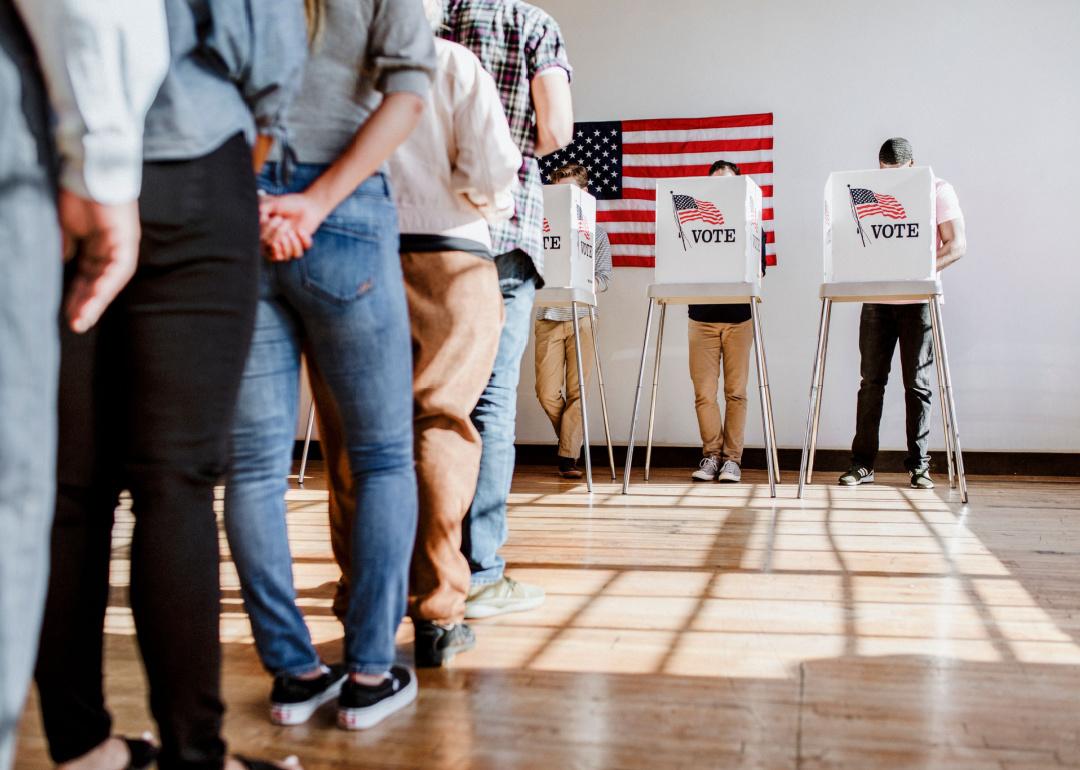
4.3 million votes: See the demographics of Maryland's voting population
4.3 million votes: See the demographics of Maryland's voting population
In 2020, 158.4 million citizens—almost two-thirds of estimated eligible voters—voted in the presidential elections, according to the Pew Research Center. The number represented a higher than average turnout, with people voting in numbers not seen since 1980 and possibly well before.
Stacker compiled voter demographics for each state and Washington, D.C., using the 2019 U.S. Census Bureau's American Community Survey (released in September 2020). Each slide shows the state's voting-eligible population (citizens who are 18 or older) and the breakdown of that population by sex, age, race, and education. Economic statistics are not included because the American Community Survey does not account for COVID-19, which affected unemployment, poverty, and medical insurance status for millions of Americans. In order to avoid making any assumptions about the data or the participants of the American Community Survey, Stacker used the exact wording of the "race" and "sex" framework that was provided in the census data.
Keep reading to see the voter demographics of your state.
Maryland by the numbers
- Voting-eligible population: 4,316,921
- Breakdown by sex: 47.5% male, 52.5% female
- Breakdown by age: 19.8% 18-29 years old, 23.9% 30-44 years old, 34.9% 45-64 years old, 21.4% 65+ years old
- Breakdown by race: 59.1% White, 30.9% Black or African American, 5.1% Asian, 5.6% Hispanic or Latino, 0.3% Native American or Alaska Native, 0.0% Native Hawaiian or Pacific Islander, 2.5% two or more races
- Breakdown by education: 2.2% less than high school education, 5.7% some high school (no diploma), 25.6% high school graduate or equivalency, 20.9% some college (no degree), 6.8% associate's degree, 21.5% bachelor's degree, 17.3% graduate or professional degree
Maryland residents are highly educated, with up to 38.8% holding either a bachelor's, graduate, or professional degree. The Pew Research Center breaks down Maryland voting trends among populations including sex, race, and religious group based on party affiliation. Both Democrat and GOP voters in Maryland share almost equally the percentage of those with Catholic, Protestant, and Mainline Protestant beliefs.
By percentage, voters aged 45–64 are the highest in every state, with registered voters over the age of 45 comprising more than half the country's population. Older voters also trend toward turning out to vote at a higher rate and played a significant role in former President Donald Trump's 2016 victory in Florida.
Along racial lines, Black or African American voters in Louisiana and Georgia comprise more than 30% of the state's registered voters. California and Texas—which award the most electoral votes at 55 and 38, respectively—boast the highest numbers of Latino voters. On the other end of the spectrum, West Virginia and Maine boast the highest percentage of white voters. A number of states had already seen record voter turnouts, with 16 seeing more than half of its registered voters casting a ballot before Election Day.
Continue reading for a glimpse into the voter demographics of neighboring states.
Delaware
- Voting-eligible population: 725,178
- Breakdown by sex: 47.5% male, 52.5% female
- Breakdown by age: 19.1% 18-29 years old, 21.2% 30-44 years old, 34.0% 45-64 years old, 25.8% 65+ years old
- Breakdown by race: 72.4% White, 21.7% Black or African American, 2.5% Asian, 5.8% Hispanic or Latino, 0.0% Native American or Alaska Native, 0.0% Native Hawaiian or Pacific Islander, 1.8% two or more races
- Breakdown by education: 2.0% less than high school education, 6.4% some high school (no diploma), 31.1% high school graduate or equivalency, 22.1% some college (no degree), 7.9% associate's degree, 18.5% bachelor's degree, 12.2% graduate or professional degree
Breaking down voting demographics by sex shows that women in Delaware surpass men by 5%, revealing the female voter's influence in the state, as seen in the League of Women Voters' present Vote411.org campaign. However, although considered a moderately liberal government, Delaware voters essentially voted equally for both political parties in all presidential elections since 1900.
Pennsylvania
- Voting-eligible population: 9,810,201
- Breakdown by sex: 48.4% male, 51.6% female
- Breakdown by age: 19.5% 18-29 years old, 22.6% 30-44 years old, 33.8% 45-64 years old, 24.1% 65+ years old
- Breakdown by race: 83.3% White, 10.6% Black or African American, 2.4% Asian, 5.6% Hispanic or Latino, 0.2% Native American or Alaska Native, 0.0% Native Hawaiian or Pacific Islander, 1.6% two or more races
- Breakdown by education: 2.5% less than high school education, 6.3% some high school (no diploma), 34.8% high school graduate or equivalency, 18.1% some college (no degree), 8.2% associate's degree, 18.7% bachelor's degree, 11.3% graduate or professional degree
With 20 electoral votes, Pennsylvania has been and remains one of the most influential states in any election. The Keystone State's 12.8 million populace makes up 4% of the total U.S. population, further showing the state's powerful electoral position. Though adjacent to states with higher minority voting groups, including New York and New Jersey, Pennsylvania's 2020 Black or African American population of 10.8% was not equal to the U.S. average of 12.5%.



